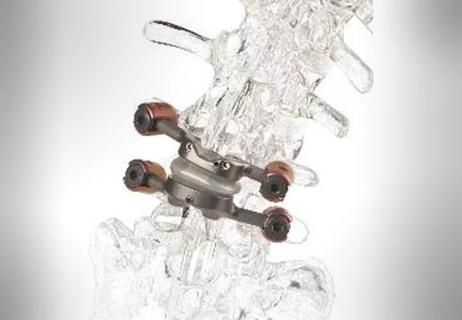Tool correlates well with sagittal vertical axis and quality-of-life measures
Assessing global shear vector (GSV) of the spine — i.e., the sum of the shear weight vectors applied on each vertebra (Figure) — can provide greater understanding of spine biomechanics, promising to one day better inform surgical evaluation for spine deformity. The GSV assessment tool, developed by a Cleveland Clinic Center for Spine Health team led by neurosurgeon Ghaith Habboub, MD, can be accessed via an online application. It can calculate GSV using a scoliosis X-ray of the spine plus patient weight.
Advertisement
Cleveland Clinic is a non-profit academic medical center. Advertising on our site helps support our mission. We do not endorse non-Cleveland Clinic products or services. Policy
“This is the first spinal assessment that accounts for the contribution of forces on each vertebra, based on alignment and weight,” says Dr. Habboub, whose group has submitted a study of the GSV metric for publication. “By providing detailed information on the shear forces pushing the spine anteriorly, this metric will help us determine how to better surgically realign the spine.”

Understanding the development of proximal junctional failure and kyphosis is critical for predicting patient outcomes and determining surgical strategies for adult spinal deformity. About 40% of patients fail to achieve a better quality of life after surgical fusion, highlighting the need for better understanding of spinal biomechanics.
Multiple metrics are currently used to help determine spinal alignment, all of which are scalar numbers that only provide measurements of angle or distance, rather than vectors (i.e., magnitude plus direction).
The sagittal vertical axis (SVA) —which provides overall spinal alignment based on radiographic spinal measurements — is most commonly used and best studied. It is insufficient for providing complete alignment goals, which also depend on sex, age, pelvic parameters and body weight.
The concept of “cone of economy” has long been used to understand global balance and its role in spinal deformity correction. If a patient’s global alignment falls outside this area, energy expenditure needs to increase to maintain balance.
Key to maintaining posture within the cone of economy is the integrity of the muscles and ligaments surrounding the vertebrae, i.e., the posterior musculoligamentous complex. This complex allows the spine to counteract the anterior shear force inherent in upright posture. Kyphosis develops as the posterior musculoligamentous complex weakens or as the anterior spine (intervertebral disc and vertebral body) collapses and shortens in height.
Advertisement
A common complication of long segment fusion of the spine is proximal junctional kyphosis. “Proximal junctional kyphosis is often associated with the shear weight vector being oriented anteriorly,” Dr. Habboub explains. “We conducted our study to quantify the forces acting upon the spine during upright posture into a two-component vector measurement (magnitude and angle) — the GSV — and thereby gain better insight into forces contributing to spinal imbalance.”
A retrospective review was conducted of 40 Cleveland Clinic patients with full-length spine radiographs available. Patients were categorized into one of four groups (n = 10 in each group) based on SVA, as follows: < 0 cm, 0 cm, 5 to 10 cm, and > 10 cm.
In addition to SVA, the following data were available: pelvic incidence, PROMIS-PH (Patient Reported Outcome Measurement Information System–Physical Health), age and body mass index (BMI).
GSV was calculated for each patient by plotting each vertebra from C2 to S1 on a local coordinate system centered on the midpoint of each vertebral body with the x-axis parallel to the endplates. Pitch — i.e., spinal rotation in the sagittal plane — was also used for analysis. GSV comprises two components:
Advertisement
GSV calculations were automated using the Global Spine Vector application, which involves uploading a full-length spine radiograph, entering the patient’s weight and clicking on the midpoint of each vertebra.
Correlational analysis of the variables was performed using one-way ANOVA testing.
The following findings support the strength of GSV for characterizing spinal deformity:
Neither BMI nor pelvic incidence were significantly different between the various SVA groups.
Although GSV does not yet have an established clinical use, Dr. Habboub says it contributes in an important way to understanding the forces that determine posture, spinal alignment and balance. His group is conducting further research to evaluate its clinical utility, as well as collecting postoperative data to determine optimal ranges to help drive surgical decision-making.
“This study of novel spinal alignment metrics and their impact on posture represents a totally novel area of research,” notes study co-author Michael Steinmetz, MD, Chair of Cleveland Clinic’s Department of Neurosurgery. “Calculation of global shear vector enables the acquisition of more information than current spinal variables we collect, and it does so without need for the cumbersome manual measurement of angles.”
Advertisement
Advertisement

Safety and efficacy demonstrated in largest case series reported to date

Insights from 15 years of experience of Cleveland Clinic’s spine tumor board

Two-year trial results find Total Posterior Spine System to be safe and effective

Success for these complex operations requires judicious patient selection and presurgical patient optimization

Meta-analyses signal an opportunity to reshape risk stratification and surgical protocols for these comorbidities

A host of factors shape when to intervene and which of three primary procedures to use

Minimally invasive approach is gaining prominence as a fast and safe outpatient procedure

Insights on leveraging collaboration and advocacy to develop and conduct needed trials